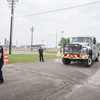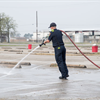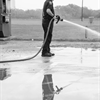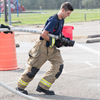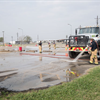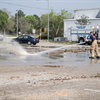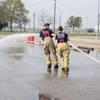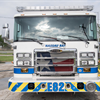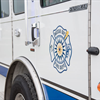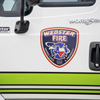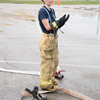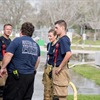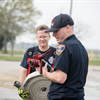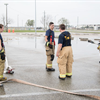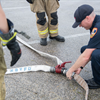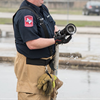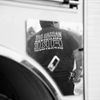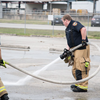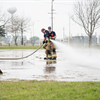Local firefighters offer a helping hand at Johnson Space Center
2017-04-06
The Nassau Bay Volunteer Fire Department (NBVFD) and Webster Fire Department came to the Gilruth Center on March 1 for a training exercise after the 19th Annual Texas Independence Trail Ride event. The NBVFD has helped JSC clean up after the trail ride since it began, and the Webster Fire Department joined the cleanup this year. Eight firefighters arrived with two fire trucks to prepare the parking lot for public use.
One of the firefighters working that day was Safety Officer Chuck Dickerson, who works in the NASA Johnson Space Center Aeroscience and Applied Mechanics Division as a system administrator for the Aerolab. He’s also been a Nassau Bay volunteer firefighter for 20 years.
Dickerson did not originally sign up to become a firefighter; instead, he was recruited to drive the fire truck in college. He had grown up driving buses, so the switch to fire trucks felt pretty comfortable.
“Volunteer firefighters want to be out fighting the fires instead of staying back with the truck, so the department was happy to have me,” Dickerson joked.
Other Webster and Nassau Bay firefighters have been airplane pilots, flight directors, co-ops and even astronauts. In fact, 80 percent of firefighters in the United States are volunteers. The NBVFD covers two square miles and serves approximately 5,000 to 6,000 residents. All nearby departments will offer support, if needed—termed “mutual aid”—so it is possible to have six departments working together on large, structural fires.
The fire trucks themselves are impressive machines, equipped with fire hoses capable of releasing 300 to 1,500 gallons of water per minute. On their own, the trucks carry between 500 to 1,500 gallons, so it is important they have access to water lines. If not, they could run out of water in just minutes.
So how are volunteer firefighters called to duty? A signal is sent to radio receivers they carry and/or their smartphones. The Nassau Bay fire station is located behind a gas station on NASA Parkway, so it’s a quick trip over for volunteers working at JSC. Firefighter candidates initially spend six weeks getting to know the current firefighters and learning more about the job requirements. To become a fully qualified, volunteers must devote significant time in outside training programs, including the Fire Academy.
Firefighting is a very physically demanding job. When fully dressed, a firefighter wears about 23 pounds of clothing and a 23-pound air tank. The air tank holds about 30 minutes of air, depending on how heavily you are breathing. You have to able to carry 50 extra pounds and be able to exert yourself in an emergency situation. As Dickerson said, “Imagine working out wearing 50 extra pounds of gear at the Gilruth.”
Volunteer firefighting is no less dangerous than working as a career firefighter. They work just as hard to reduce damage and save lives in fire and medical emergencies. These men and women strive to keep our communities safe, but their health risks do not end after a fire emergency is over. Heart attacks due to overexertion are the leading cause of death for firefighters, which unfortunately tend to strike after the emergency situation is over and the body has had time to rest. Physical fitness requirements have been instituted to prevent health risks related to overexertion on the job.
Dickerson continues to volunteer as a firefighter because he believes the skills he uses are helpful for his community. Although it is not easy to balance work, family and his firefighting duties, he is quick to point out that “someone else pays for my hobby”—a definite plus.
Interested in learning about what it takes to be a volunteer firefighter? Click here to learn more.
Eric Smith
NASA Johnson Space Center
One of the firefighters working that day was Safety Officer Chuck Dickerson, who works in the NASA Johnson Space Center Aeroscience and Applied Mechanics Division as a system administrator for the Aerolab. He’s also been a Nassau Bay volunteer firefighter for 20 years.
Dickerson did not originally sign up to become a firefighter; instead, he was recruited to drive the fire truck in college. He had grown up driving buses, so the switch to fire trucks felt pretty comfortable.
“Volunteer firefighters want to be out fighting the fires instead of staying back with the truck, so the department was happy to have me,” Dickerson joked.
Other Webster and Nassau Bay firefighters have been airplane pilots, flight directors, co-ops and even astronauts. In fact, 80 percent of firefighters in the United States are volunteers. The NBVFD covers two square miles and serves approximately 5,000 to 6,000 residents. All nearby departments will offer support, if needed—termed “mutual aid”—so it is possible to have six departments working together on large, structural fires.
The fire trucks themselves are impressive machines, equipped with fire hoses capable of releasing 300 to 1,500 gallons of water per minute. On their own, the trucks carry between 500 to 1,500 gallons, so it is important they have access to water lines. If not, they could run out of water in just minutes.
So how are volunteer firefighters called to duty? A signal is sent to radio receivers they carry and/or their smartphones. The Nassau Bay fire station is located behind a gas station on NASA Parkway, so it’s a quick trip over for volunteers working at JSC. Firefighter candidates initially spend six weeks getting to know the current firefighters and learning more about the job requirements. To become a fully qualified, volunteers must devote significant time in outside training programs, including the Fire Academy.
Firefighting is a very physically demanding job. When fully dressed, a firefighter wears about 23 pounds of clothing and a 23-pound air tank. The air tank holds about 30 minutes of air, depending on how heavily you are breathing. You have to able to carry 50 extra pounds and be able to exert yourself in an emergency situation. As Dickerson said, “Imagine working out wearing 50 extra pounds of gear at the Gilruth.”
Volunteer firefighting is no less dangerous than working as a career firefighter. They work just as hard to reduce damage and save lives in fire and medical emergencies. These men and women strive to keep our communities safe, but their health risks do not end after a fire emergency is over. Heart attacks due to overexertion are the leading cause of death for firefighters, which unfortunately tend to strike after the emergency situation is over and the body has had time to rest. Physical fitness requirements have been instituted to prevent health risks related to overexertion on the job.
Dickerson continues to volunteer as a firefighter because he believes the skills he uses are helpful for his community. Although it is not easy to balance work, family and his firefighting duties, he is quick to point out that “someone else pays for my hobby”—a definite plus.
Interested in learning about what it takes to be a volunteer firefighter? Click here to learn more.
Eric Smith
NASA Johnson Space Center








